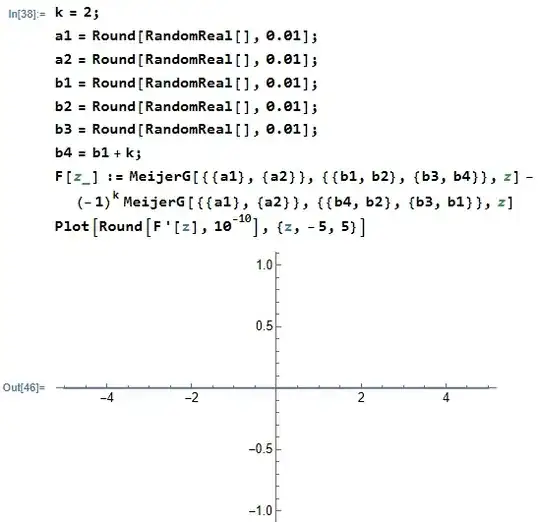While thinking about this question about the Meijer G function, I encountered the following identity listed at https://en.wikipedia.org/wiki/Meijer_G-function#Basic_properties_of_the_G-function (the fifth one in that section) which I have reworked a little bit for clarity:
$$G^{m,n}_{p,q}\left(\begin{matrix}\boldsymbol a \\ (b_1,b_2,\dots,b_{q-1},b_q)\end{matrix}\bigg|~z\right)=(-1)^{b_1-b_q}G^{m,n}_{p,q}\left(\begin{matrix}\boldsymbol a \\ (b_q,b_2,\dots,b_{q-1},b_1)\end{matrix}\bigg|~z\right) \\ \text{when}~m< q~\text{and}~b_1-b_q\in\Bbb Z$$
But this would imply, for example $$G^{2,1}_{1,4}\left(\begin{matrix} (1) \\ (0,1,\frac{1}{2},1)\end{matrix}\bigg|~z\right)=-G^{2,1}_{1,4}\left(\begin{matrix} (1) \\ (1,1,\frac{1}{2},0)\end{matrix}\bigg|~z\right)$$ Which, due to the permutation symmetry of the Meijer G, means $$G^{2,1}_{1,4}\left(\begin{matrix} (1) \\ (0,1,\frac{1}{2},1)\end{matrix}\bigg|~z\right)=-G^{2,1}_{1,4}\left(\begin{matrix} (1) \\ (1,1,0,\frac{1}{2})\end{matrix}\bigg|~z\right)$$ And finally, due to the cancellation identity (first identity on the linked Wikipedia page) This would mean $$G^{2,0}_{0,3}\left(\begin{matrix} - \\ (0,1,\frac{1}{2})\end{matrix}\bigg|~z\right)=-G^{2,1}_{1,4}\left(\begin{matrix} (1) \\ (1,1,0,\frac{1}{2})\end{matrix}\bigg|~z\right)$$ But this is clearly not the case! In the linked question it is shown, both numerically and analytically, that $$G^{2,0}_{0,3}\left(\begin{matrix} - \\ (0,1,\frac{1}{2})\end{matrix}\bigg|~z\right)+G^{2,1}_{1,4}\left(\begin{matrix} (1) \\ (1,1,0,\frac{1}{2})\end{matrix}\bigg|~z\right)=\frac{1}{\sqrt{\pi}}$$
So, I pondered - maybe Wikipedia meant the equality up to a constant difference? That is to say, perhaps the Wikipedia identity should instead read $$\frac{\mathrm d}{\mathrm d z}\left[G^{m,n}_{p,q}\left(\begin{matrix}\boldsymbol a \\ (b_1,b_2,\dots,b_{q-1},b_q)\end{matrix}\bigg|~z\right)-(-1)^{b_1-b_q}G^{m,n}_{p,q}\left(\begin{matrix}\boldsymbol a \\ (b_q,b_2,\dots,b_{q-1},b_1)\end{matrix}\bigg|~z\right)\right]=0 \\ \text{when}~m< q~\text{and}~b_1-b_q\in\Bbb Z\tag{*}$$
To test my hypothesis, I wrote the following little script in Mathematica:
k = 1;
b1 = Round[RandomReal[], 0.01]
b2 = Round[RandomReal[], 0.01]
b3 = Round[RandomReal[], 0.01]
b4 = b1 + k
F[z_] := MeijerG[{{}, {}}, {{b1, b2}, {b3, b4}}, z] - (-1)^
k MeijerG[{{}, {}}, {{b4, b2}, {b3, b1}}, z]
Plot[Round[F'[z], 10^(-10)], {z, -5, 5}]
Basically, I generate three random parameters $b_1,b_2,b_3$ that are between $0$ and $1$, and rounded to two decimal places to make the following numerics easier. I then let $k$ be any integer ($1$ in this case) and let $b_4=b_1+k$, so that the difference between $b_1$ and $b_4$ is an integer. (I have set $k=1$ in the above but I find the program produces the expected result for other integer values of $k$ as well.) I then numerically evaluate and plot $$\frac{\mathrm d}{\mathrm dz}\left[G^{2,0}_{0,3}\left(\begin{matrix}- \\ (b_1,b_2,b_3,b_4)\end{matrix}\bigg|~z\right)-(-1)^{b_1-b_4}G^{2,0}_{0,3}\left(\begin{matrix}- \\ (b_4,b_2,b_3,b_1)\end{matrix}\bigg|~z\right)\right]$$
If my proposed formula is right, I would expect the graph to just be a flat line at zero. (I rounded the values to $10^{-10}$ so that it wouldn't output a bunch of machine precision noise.)
And, Lo and Behold, that appears to be the case. I have ran this program several times, for example:
I even tried putting in some upper parameters, and it still seems to work, for example
My questions:
- Can someone prove that my formula (equation $(*)$) is correct?
- Is it possible to work out what the constant difference will be in general? Some combination of Gamma functions perhaps?
Thanks in advance.

